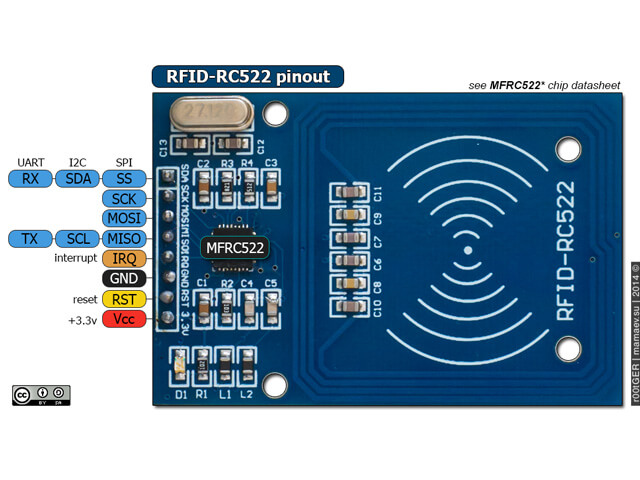RC522 NFC/RFID

The rc522 component allows you to use RC522 NFC/RFID controllers
(datasheet, Ali Express)
with ESPHome. ESPHome can read the UID from the tag. Every NFC/RFID tag has a unique “UID” value assigned at the time
of manufacture. Tags can be associated with binary sensors, making it easy to determine when a specific tag is present.
You can also use the tag information directly within ESPHome automations/lambdas. See Setting Up Tags for
information on how to setup individual binary sensors using this component.
The RC522 IC supports SPI, I²C and UART communication protocols; ESPHome can use either SPI or I²C.
Component/Hub
If you have a module as shown in the image above, it can only be used in SPI mode (unless hacked) and you must define a SPI bus in your configuration with both the miso_pin and mosi_pin set.
If you have a RC522 which communicates via I²C (as on the M5 Stack), you need to have an I²C bus configured.
Over SPI
The rc522_spi component allows you to use RC522 NFC/RFID controllers with ESPHome. This component is a global hub
that establishes the connection to the RC522 via SPI. Using RC522 binary sensors,
you can then create individual binary sensors that track if an NFC/RFID tag is currently detected by the RC522.
spi:
rc522_spi:
cs_pin: GPIOXX
binary_sensor:
- platform: rc522
uid: 74-10-37-94
name: "RC522 RFID Tag"Configuration variables
cs_pin (Required, Pin Schema): The pin on the ESP that the chip select line is connected to.
reset_pin (Optional, Pin Schema): The pin connected to the RST line. Some tests shows the RC522 working okay without this.
update_interval (Optional, Time): The duration of each scan on the RC522. This affects the duration that the individual binary sensors stay active when they’re found. If a device is not found within this time window, it will be marked as not present. Defaults to
1s.spi_id (Optional, ID): Manually specify the ID of the SPI Component if you want to use multiple SPI buses.
id (Optional, ID): Manually specify the ID for this component.
on_tag (Optional, Automation): An automation to perform when a tag is read. See
on_tagTrigger.on_tag_removed (Optional, Automation): An automation to perform after a tag is removed. See
on_tag_removedTrigger.
Over I²C
The rc522_i2c component allows you to use RC522 NFC/RFID controllers with ESPHome. This component is a global hub
that establishes the connection to the RC522 via I²C (also available over SPI). Using the
RC522 binary sensors you can then create individual binary sensors that track if
an NFC/RFID tag is currently detected by the RC522.
i2c:
rc522_i2c:
binary_sensor:
- platform: rc522
uid: 74-10-37-94
name: "RC522 RFID Tag"Configuration variables
address (Optional, int): Manually specify the I²C address of the sensor. Defaults to
0x28.reset_pin (Optional, Pin Schema): The pin connected to the RST line. Some tests shows the RC522 working okay without this.
update_interval (Optional, Time): The duration of each scan on the RC522. This affects the duration that the individual binary sensors stay active when they’re found. If a device is not found within this time window, it will be marked as not present. Defaults to
1s.i2c_id (Optional, ID): Manually specify the ID of the I²C Component if you want to use multiple I²C buses.
id (Optional, ID): Manually specify the ID for this component.
on_tag (Optional, Automation): An automation to perform when a tag is read. See
on_tagTrigger.on_tag_removed (Optional, Automation): An automation to perform after a tag is removed. See
on_tag_removedTrigger.
Triggers
on_tag Trigger
This automation will be triggered immediately after the RC522 identifies a tag.
The parameter x this trigger provides is of type std::string and is the tag UID in the format
74-10-37-94. The configuration below will for example publish the tag ID on the MQTT topic rc522/tag.
rc522_spi: # or rc522_i2c
# ...
on_tag:
then:
- mqtt.publish:
topic: rc522/tag
payload: !lambda 'return x;'A tag scanned event can also be sent to the Home Assistant tag component
using homeassistant.tag_scanned Action.
rc522_spi: # or rc522_i2c
# ...
on_tag:
then:
- homeassistant.tag_scanned: !lambda 'return x;'on_tag_removed Trigger
This automation will be triggered when the RC522 no longer “sees” a previously scanned tag.
The parameter x this trigger provides is of type std::string and is the removed tag UID in the format
74-10-37-94. The example configuration below will publish the removed tag ID on the MQTT topic pn7160/tag_removed.
rc522_spi: # or rc522_i2c
# ...
on_tag_removed:
then:
- mqtt.publish:
topic: rc522/tag_removed
payload: !lambda 'return x;'rc522 Binary Sensor
The rc522 binary sensor platform lets you track if an NFC/RFID tag with a given unique id (uid ) is currently
being detected by the RC522 or not.
# Example configuration entry
spi:
clk_pin: D0
miso_pin: D1
mosi_pin: D2
rc522_spi: # or rc522_i2c
cs_pin: D3
update_interval: 1s
binary_sensor:
- platform: rc522
uid: 74-10-37-94
name: "RC522 RFID Tag"Configuration variables
uid (Required, string): The unique ID of the NFC/RFID tag. This is a hyphen-separated list of hexadecimal values. For example
74-10-37-94.All other options from Binary Sensor.
Setting Up Tags
To set up binary sensors for specific NFC/RFID tags you first have to know their unique IDs. To obtain this id, first set up a simple RC522 configuration without any binary sensors like above.
When your code is running and you approach the RC522 with an NFC/RFID Tag, you should see a message like this:
Found new tag '74-10-37-94'Then copy this id and create a binary_sensor entry as in the configuration example. Repeat this process for each tag.

